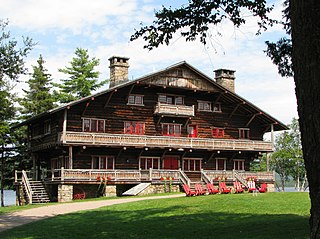
Great Camp Sagamore is one of several historic Great Camps located in the Adirondack Mountains of northern New York State.

This is intended to be a complete list of properties and districts listed on the National Register of Historic Places in Orleans County, New York. The locations of National Register properties and districts may be seen in a map by clicking on "Map of all coordinates". Two listings, the New York State Barge Canal and the Cobblestone Historic District, are further designated a National Historic Landmark.

The House at 11 Wave Avenue in Wakefield, Massachusetts is a well-preserved example of Queen Anne/Stick-style architecture. Built between 1875 and 1888, it was listed on the National Register of Historic Places in 1989.
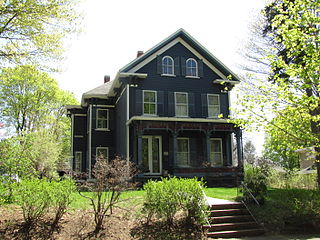
15 Wave Avenue is a well-preserved Italianate style house in Wakefield, Massachusetts. It was built between 1875 and 1883, and was listed on the National Register of Historic Places on July 6, 1989.

33-61 Emerson Place Row is a set of historic rowhouses located at Buffalo in Erie County, New York. It is one of a rare surviving group of speculative multi-unit frame residences designed to resemble rowhouses in the city of Buffalo. It was built in 1893, by land dealer and speculator Benjamin B. Rice. The seven unit row features decorative shingle sheathing and two-story bow windows.
17-21 Emerson Place Row was a set of historic rowhouses located at Buffalo in Erie County, New York. It was built in 1900, by land dealer and speculator George C. Rice and demolished in the early 2000s due to neglect.

C. W. Miller Livery Stable is a historic multi-story livery stable located at Buffalo in Erie County, New York. It is a six-story, rectangular masonry building 65 feet wide and 236 feet deep, built between 1892 and 1894. As horses were phased out and automobiles became more common, it was converted for use as a parking garage.

There are 71 properties listed on the National Register of Historic Places in Albany, New York, United States. Six are additionally designated as National Historic Landmarks (NHLs), the most of any city in the state after New York City. Another 14 are historic districts, for which 20 of the listings are also contributing properties. Two properties, both buildings, that had been listed in the past but have since been demolished have been delisted; one building that is also no longer extant remains listed.

The Meetinghouse is a historic house on Monument Square in Hollis, New Hampshire. Built in 1744, its oldest portion is a rare regional example of a Georgian period saltbox house. The structure was extended with a new west-facing facade sometime later, and has seen both residential and commercial use. The house was listed on the National Register of Historic Places in 1982.

The Hampstead Meetinghouse, also once known as Hampstead Town Hall, is a historic meeting house at 20 Emerson Avenue in Hampstead, New Hampshire. The core of this dual-purpose structure was begun in 1749, although its interior was not completely finished until about 1768. It is one of a number of fairly well-preserved 18th-century meeting houses in southeastern New Hampshire, and was listed on the National Register of Historic Places in 1980.

This is intended to be a complete list of properties and districts listed on the National Register of Historic Places in Rochester, New York, United States. The locations of National Register properties and districts may be seen in an online map by clicking on "Map of all coordinates".

Tianderah is a historic home located at Gilbertsville in Otsego County, New York. It was built in 1887 by Boston-based architect William Ralph Emerson. It is an "L" shaped, stone Romanesque Revival and Shingle style residence dramatically overlooking the village and complemented by a stone and shingle style stable. The house is three stories and has a steep gambrel roof, a full two stories high. It is built of rock faced bluestone and features a 15-foot-deep (4.6 m) verandah that runs across the front of the main facade. Also on the property is a carriage shed, carriage house, and much of the original landscaping. The estate was placed on the market in July 2007 for $3 million, the highest price ever asked for a private residence in Otsego County.
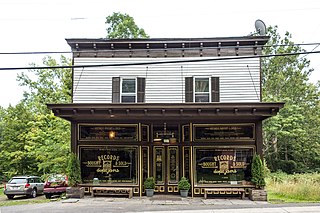
Ford's Store is a historic general store located in the hamlet of Oak Hill in the town of Durham in Greene County, New York. It was built in 1870 as a two-story commercial building in the Italianate style, and was listed on the National Register of Historic Places in 2001. The restored storefront is composed of a recessed entry flanked by display windows. John Bonafide, preservation analyst from the New York State Parks Commission, said of the building, “As constructed, Ford’s Store is a representative example of Italianate style commercial architecture, popular in America during the third quarter of the nineteenth century. Built on the site of an earlier store and harness shop, the building is architecturally significant as an intact example of simple, mid-nineteenth century commercial architecture in the hamlet of Oak Hill. Today, the Ford’s Store building is one of two intact commercial storefronts to survive in the community. Despite years of neglect and damage, Ford’s store, as restored, survives with a high degree of its architectural integrity.”
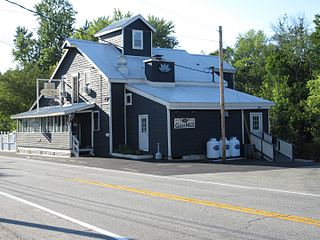
Warrensburg Mills Historic District is a national historic district located at Warrensburg, Warren County, New York. It includes 58 contributing buildings and four contributing structures. It encompasses a number of mill complexes and homes related to the development of Warrensburg. It includes a mill dam, Emerson Sawmill, grist mill, early shirt factory (1878), later shirt factory (1898), office building (1855), coal storage shed, grain warehouses, and 51 wood residences and one brick residence. Also within the district are the Osborne Bridge, and Woolen Mill Bridge.

The Ralph Waldo Emerson Indianapolis Public School #58 is a historic school building located on N. Linwood St. in Indianapolis, Indiana, United States. It was built in 1907 according to a design by R.P. Daggett and Co. It is a two-story, rectangular brick building on a raised basement in a simplified Classical Revival style. Additions were made to the building in 1917, 1921, and 1967.

The Back River Farm, also known as the Samuel Emerson Farm, is a historic farmstead on Bay View Road in Dover, New Hampshire. The land along the Bellamy River has been farmed since Samuel Emerson acquired 30 acres (12 ha) in the area in 1696, and is the only surviving period farmstead in the area. The farm, including a mid-18th century farmhouse, was listed on the National Register of Historic Places in 1984.

The Hewitt House is a historic house on United States Route 4 in Enfield, New Hampshire. Built in 1871, it is a particularly fine example of late Italianate architecture, built for the manager of local woolen mills. The house was listed on the National Register of Historic Places in 1985, and included in the Enfield Village Historic District in 2010.
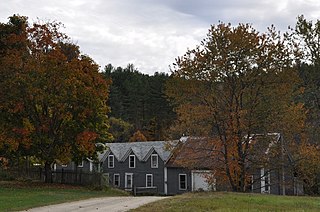
The Purnell House is a historic house on New Hampshire Route 10 in Goshen, New Hampshire. Built about 1830, this Cape style house is one of a cluster of 19th-century plank-frame houses in the town. The house was listed on the National Register of Historic Places in 1985.

Emerson School is a historic building located in Waterloo, Iowa, United States. It is oldest extant school campus on the city's west side. Emerson was established in 1893 when its first building was constructed on this property. It was the third school in West Waterloo. The original building was replaced when the present main building was completed in 1906. The annex was built ten years later to accommodate the school's increased enrollment. They are connected by a hyphen. The complex was designed by Waterloo architect John G. Ralston. The original building is a two-story brick structure on a raised limestone basement designed in the Neoclassical style. It features broken pediment gable ends, stylized pilasters on the gable ends of the upper level, Palladian dormers, and corner pilaster capitals. The annex was designed in the Second Renaissance Revival style. It is also a two-story brick structure. Typical of this style the annex features distinct horizontal divisions separated by belt and stringcourses. There is also a parapet frieze across the top. In 1973 the building became Expo Alternative High School. The building was closed in 1981, and it was later sold. It was listed on the National Register of Historic Places in 2004.

The St. Johnsbury Federal Fish Culture Station, also known as the St. Johnsbury Federal Fish Hatchery, was a United States government-funded fish hatchery on Emerson Falls Road in St. Johnsbury, Vermont. The hatchery operated from 1895 to 1960, producing fish stock for headwater tributaries of the Connecticut River and St. Lawrence River in northern New England and New York. The surviving facilities of the hatchery, now adaptively reused for other purposes and in private ownership, were listed on the National Register of Historic Places in 2005.























